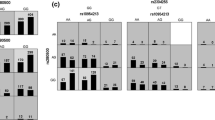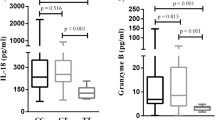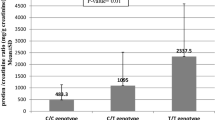Abstract
Virus-induced signaling adapter (VISA), an important adaptor protein linking both RIG-I and MDA-5 to downstream signaling events, may mediates the activation of NF kappaB and IRFs and the induction of type I IFN. As the evidence has showed that Toll-like receptors (TLRs), I-IFN and IFN-inducible genes contribute to the pathogenesis of systemic lupus erythematosus (SLE), the aim of the current study was to investigate the possible associations between the VISA gene and SLE. Four single nucleotide polymorphisms (SNPs), rs17857295, rs2326369, rs7262903, and rs7269320, in VISA gene were genotyped in 123 SLE patients and 95 healthy controls. Genotyping was performed using direct sequencing the purified PCR products. Associations were analyzed by using the chi-square test and Fisher’s exact test. Haplotype analysis was performed using haploview and PHASE2.1. None of the four SNPs was found to be associated with SLE. The four-SNPs haplotype analysis showed different effect between cases and controls. While the SNPs, rs17857295 and rs2326369, were found to be associated with the renal nephritis and arthritis of SLE patient, respectively. The SNPs rs7269320 showed associations with different manifestations. Our data reveal that polymorphisms in the VISA gene may be related to disease susceptibility and manifestations of SLE.

Similar content being viewed by others
References
Danchenko N, Satia JA, Anthony MS (2006) Epidemiology of systemic lupus erythematosus: a comparison of worldwide disease burden. Lupus 15:308–318. doi:10.1191/0961203306lu2305xx
Wang J, Yang S, Chen JJ et al (2007) Systemic lupus erythematosus: a genetic epidemiology study of 695 patients from China. Arch Dermatol Res 298:485–491. doi:10.1007/s00403-006-0719-4
Xu LG, Wang YY, Han KJ, Li LY, Zhai Z, Shu HB (2005) VISA is an adapter protein required for virus-triggered IFN-beta signaling. Mol Cell 19:727–740. doi:10.1016/j.molcel.2005.08.014
Gack MU, Kirchhofer A, Shin YC et al (2008) Roles of RIG-I N-terminal tandem CARD and splice variant in TRIM25-mediated antiviral signal transduction. Proc Natl Acad Sci USA 105:16743–16748. doi:10.1073/pnas.0804947105
Cheng G, Zhong J, Chung J, Chisari FV (2007) Double-stranded DNA and double-stranded RNA induce a common antiviral signaling pathway in human cells. Proc Natl Acad Sci USA 104:9035–9040. doi:10.1073/pnas.0703285104
Xu CJ, Zhang WH, Pan HF, Li XP, Xu JH, Ye DQ (2009) Association study of a single nucleotide polymorphism in the exon 2 region of toll-like receptor 9 (TLR9) gene with susceptibility to systemic lupus erythematosus among Chinese. Mol Biol Rep 36:2245–2248. doi:10.1007/s11033-008-9440-z
Komatsuda A, Wakui H, Iwamoto K et al (2008) Up-regulated expression of Toll-like receptors mRNAs in peripheral blood mononuclear cells from patients with systemic lupus erythematosus. Clin Exp Immunol 152:482–487. doi:10.1111/j.1365-2249.2008.03646.x
Nacionales DC, Kelly-Scumpia KM, Lee PY et al (2007) Deficiency of the type I interferon receptor protects mice from experimental lupus. Arthritis Rheum 56:3770–3783. doi:10.1002/art.23023
Cai LQ, Wang ZX, Lu WS et al (2010) A single-nucleotide polymorphism of the TNFAIP3 gene is associated with systemic lupus erythematosus in Chinese Han population. Mol Biol Rep 37:389–394. doi:10.1007/s11033-009-9818-6
Wagner H, Bauer S (2006) All is not Toll: new pathways in DNA recognition. J Exp Med 203:265–268. doi:10.1084/jem.20052191
Akira S, Takeda K (2004) Toll-like receptor signalling. Nat Rev Immunol 4:499–511. doi:10.1038/nri1391
Tan EM, Cohen AS, Fries JF et al (1982) The 1982 revised criteria for the classification of systemic lupus erythematosus. Arthritis Rheum 25:1271–1277
Meurs EF, Breiman A (2007) The interferon inducing pathways and the hepatitis C virus. World J Gastroenterol 13:2446–2454
Meylan E, Curran J, Hofmann K et al (2005) Cardif is an adaptor protein in the RIG-I antiviral pathway and is targeted by hepatitis C virus. Nature 437:1167–1172. doi:10.1038/nature04193
Lei Y, Moore CB, Liesman RM et al (2009) MAVS-mediated apoptosis and its inhibition by viral proteins. PLoS One 4:e5466. doi:10.1371/journal.pone.0005466
Biacchesi S, LeBerre M, Lamoureux A et al (2009) Mitochondrial antiviral signaling protein plays a major role in induction of the fish innate immune response against RNA and DNA viruses. J Virol 83:7815–7827. doi:10.1128/JVI.00404-09
Shih PB, Manzi S, Shaw P et al (2008) Genetic variation in C-reactive protein (CRP) gene may be associated with risk of systemic lupus erythematosus and CRP concentrations. J Rheumatol 35:2171–2178
Yang W, Zhao M, Hirankarn N et al (2009) ITGAM is associated with disease susceptibility and renal nephritis of systemic lupus erythematosus in Hong Kong Chinese and Thai. Hum Mol Genet 18:2063–2070. doi:10.1093/hmg/ddp118
Davidson S (2000) Research suggests importance of haplotypes over SNPs. Nat Biotechnol 18:1134–1135. doi:10.1038/81100
Castano-Rodriguez N, Diaz-Gallo LM, Pineda-Tamayo R, Rojas-Villarraga A, Anaya JM (2008) Meta-analysis of HLA-DRB1 and HLA-DQB1 polymorphisms in Latin American patients with systemic lupus erythematosus. Autoimmun Rev 7:322–330. doi:10.1016/j.autrev.2007.12.002
Lee YH, Woo JH, Choi SJ, Ji JD, Song GG (2010) Functional monocyte chemoattractant protein-1 promoter -2518 polymorphism and systemic lupus erythematosus: a meta-analysis. Mol Biol Rep 37:3421–3426
Mao C, Pan H, Chen Q, Wang X, Ye D, Qiu L (2010) Association between Fc receptor-like 3 C169T polymorphism and risk of systemic lupus erythematosus: a meta-analysis. Mol Biol Rep 37:191–196. doi:10.1007/s11033-009-9591-6
Ji JD, Lee WJ, Kong KA et al (2010) Association of STAT4 polymorphism with rheumatoid arthritis and systemic lupus erythematosus: a meta-analysis. Mol Biol Rep 37:141–147. doi:10.1007/s11033-009-9553-z
Leng RX, Pan HF, Qin WZ, et al (2010) TWEAK as a target for therapy in systemic lupus erythematosus. Mol Biol Rep [Epub ahead of print]. doi:10.1007/s11033-010-0144-9
Pan HF, Wu GC, Li WP, Li XP, Ye DQ (2010) High Mobility Group Box 1: a potential therapeutic target for systemic lupus erythematosus. Mol Biol Rep 37:1191–1195. doi:10.1007/s11033-009-9485-7
Pan HF, Zhang N, Li WX, Tao JH, Ye DQ (2010) TIM-3 as a new therapeutic target in systemic lupus erythematosus. Mol Biol Rep 37:395–398. doi:10.1007/s11033-009-9833-7
Acknowledgments
This work was supported by Shandong Province Natural Science Foundation (ZR2009CM139) and Shandong Provincial Science and Technology Development Projects (2009GG10002008).
Conflict of interest
None declared.
Author information
Authors and Affiliations
Corresponding author
Rights and permissions
About this article
Cite this article
Liu, X., Jiao, Y., Wen, X. et al. Possible association of VISA gene polymorphisms with susceptibility to systemic lupus erythematosus in Chinese population. Mol Biol Rep 38, 4583–4588 (2011). https://doi.org/10.1007/s11033-010-0590-4
Received:
Accepted:
Published:
Issue Date:
DOI: https://doi.org/10.1007/s11033-010-0590-4




